The U.S. textile industry is vanishing from our economic landscape. Its decline not only harms textile workers and ancillary industries but also damages our producers of natural fiber and the rural economy. This is not a buggy whip or 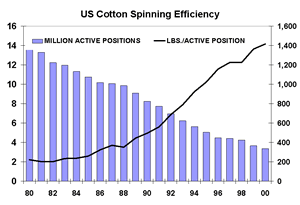 outmoded technology issue. The textile industry is one of the most innovative and productive manufacturing sectors in the U.S. economy. The items produced today use computer aided design with high-tech imagery for shaping and color, scanners and inventory management processes for streamlining just-in-time deliveries and widely recognized environmental programs for product recycling and air quality control. Investment in yarn spinning machinery and technology has made the U.S. textile industry the most efficient in the world. In fact, productivity gains in the U.S. textile industry have only been surpassed by the U.S. electronics and computers industries. Although the number of active spinning positions has fallen by more than one-half in the past 20 years, the pounds of cotton used per position have increased seven-fold, from 200 pounds in 1980 to an estimated 1,400 pounds by 2000.
outmoded technology issue. The textile industry is one of the most innovative and productive manufacturing sectors in the U.S. economy. The items produced today use computer aided design with high-tech imagery for shaping and color, scanners and inventory management processes for streamlining just-in-time deliveries and widely recognized environmental programs for product recycling and air quality control. Investment in yarn spinning machinery and technology has made the U.S. textile industry the most efficient in the world. In fact, productivity gains in the U.S. textile industry have only been surpassed by the U.S. electronics and computers industries. Although the number of active spinning positions has fallen by more than one-half in the past 20 years, the pounds of cotton used per position have increased seven-fold, from 200 pounds in 1980 to an estimated 1,400 pounds by 2000.
The U.S. possesses the world's largest retail market for cotton textile and apparel products. The promotion campaigns of Cotton Incorporated have helped create a domestic retail cotton 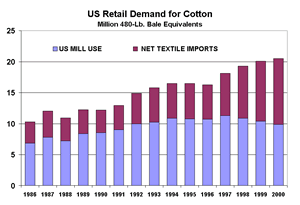 market in excess of 20 million 480-lb. bale equivalents, up from 13 million just 10 years ago. For the year 2000, the U.S. accounted for 22.5% of the world's cotton textile and apparel market – up from 14.3% one decade earlier. Unfortunately, imports of foreign-manufactured textile and apparel products made from foreign cottons are growing at a staggering rate. From 1993 to 1996, net imports of cotton textiles and apparel averaged the equivalent of 5.6 million bales; by 2000, imports had grown to 10.6 million-bale equivalents. The surge in imports accelerated sharply in the later-1990s amidst aggressive Asian export behavior and rapid appreciation of the U.S. dollar.
market in excess of 20 million 480-lb. bale equivalents, up from 13 million just 10 years ago. For the year 2000, the U.S. accounted for 22.5% of the world's cotton textile and apparel market – up from 14.3% one decade earlier. Unfortunately, imports of foreign-manufactured textile and apparel products made from foreign cottons are growing at a staggering rate. From 1993 to 1996, net imports of cotton textiles and apparel averaged the equivalent of 5.6 million bales; by 2000, imports had grown to 10.6 million-bale equivalents. The surge in imports accelerated sharply in the later-1990s amidst aggressive Asian export behavior and rapid appreciation of the U.S. dollar.
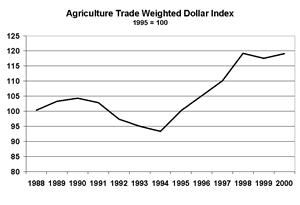 The trade-weighted U.S. agricultural exchange rate index, as reported by USDA, shows the rapid and sustained increase in the dollar's buying power since 1995. Strong growth of the U.S. economy and relatively high U.S. interest rates, combined with a financial crisis in Asia and elsewhere, spurred foreigners to invest heavily in U.S. equity and financial markets. The resulting demand for U.S. currency led to the subsequent strong appreciation of the dollar. Over the past five years, the agricultural exchange rate has appreciated by approximately 25% against a market basket of foreign currencies. Against some individual currencies, the appreciation has been far greater. For example, the U.S. dollar has appreciated by almost 50% against the Pakistani rupee since 1995. Not surprisingly, imports of cotton yarn and textile products from Pakistan almost doubled by 2000 to about 1.24 million-bale equivalents.
The trade-weighted U.S. agricultural exchange rate index, as reported by USDA, shows the rapid and sustained increase in the dollar's buying power since 1995. Strong growth of the U.S. economy and relatively high U.S. interest rates, combined with a financial crisis in Asia and elsewhere, spurred foreigners to invest heavily in U.S. equity and financial markets. The resulting demand for U.S. currency led to the subsequent strong appreciation of the dollar. Over the past five years, the agricultural exchange rate has appreciated by approximately 25% against a market basket of foreign currencies. Against some individual currencies, the appreciation has been far greater. For example, the U.S. dollar has appreciated by almost 50% against the Pakistani rupee since 1995. Not surprisingly, imports of cotton yarn and textile products from Pakistan almost doubled by 2000 to about 1.24 million-bale equivalents.
This surge in imported cotton products has decimated U.S. textile mills. In 1997, U.S. mill use of cotton was 11.4 million bales; by 2000, it had declined to only 9.5 million bales. As 2001 begins, U.S. mill use has continued to plummet with recent estimates of textile consumption falling below 8.5 million bales. The decline in U.S. mill demand for raw cotton directly impacts 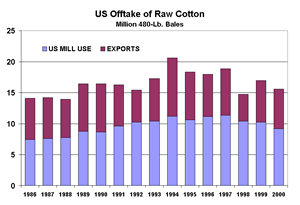 the economic fortunes of all other sectors of the U.S. cotton industry. Sales to domestic spinning mills provide stability to the level of overall annual offtake of U.S. raw cotton. Annual export volume varies much more widely than U.S. mill demand and, therefore, is a source of significant volatility in prices. The ongoing decline in mill demand has sharply reduced the overall level of offtake for U.S. cotton and is impacting prices to U.S. cotton growers. Combined with the difficulties stemming from highly variable raw cotton export opportunities, U.S. futures market values have fallen steeply and U.S. cotton growers are facing prices well below USDA's estimated cost of production. In early June 2001, the futures price of cotton is 41 cents, just one-half of the value at the time the 1995 farm law was passed.
the economic fortunes of all other sectors of the U.S. cotton industry. Sales to domestic spinning mills provide stability to the level of overall annual offtake of U.S. raw cotton. Annual export volume varies much more widely than U.S. mill demand and, therefore, is a source of significant volatility in prices. The ongoing decline in mill demand has sharply reduced the overall level of offtake for U.S. cotton and is impacting prices to U.S. cotton growers. Combined with the difficulties stemming from highly variable raw cotton export opportunities, U.S. futures market values have fallen steeply and U.S. cotton growers are facing prices well below USDA's estimated cost of production. In early June 2001, the futures price of cotton is 41 cents, just one-half of the value at the time the 1995 farm law was passed.
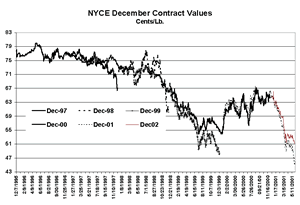 The U.S. textile industry and the U.S. cotton grower have a mutual economic interest in a strong and vibrant U.S. textile and apparel sector. The infrastructure of the U.S. cotton industry is also dependent on the volume of business conducted between these sectors. It is imperative that U.S. agricultural and trade policy recognize the fundamental economic relationship between these industries and discover policies that can address the imbalances wrought by external economic forces or distortions in foreign industrial policies that damage U.S. manufacturing and agricultural interests.
The U.S. textile industry and the U.S. cotton grower have a mutual economic interest in a strong and vibrant U.S. textile and apparel sector. The infrastructure of the U.S. cotton industry is also dependent on the volume of business conducted between these sectors. It is imperative that U.S. agricultural and trade policy recognize the fundamental economic relationship between these industries and discover policies that can address the imbalances wrought by external economic forces or distortions in foreign industrial policies that damage U.S. manufacturing and agricultural interests.

